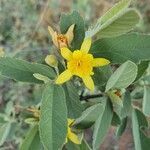Shrub or small tree to 5(–9.5) m tall; young branches densely brownish stellate-pubescent.. Leaves oblong to ovate or obovate-oblong, 1.3–10 cm long, 0.7–4.5 cm wide, acute to acuminate at the apex, rounded to obliquely truncate at the base and very asymmetric, margin serrate, sometimes coarsely so, green and minutely stellate-pubescent above, sometimes sparsely so, densely evenly whitish tomentellous beneath, sometimes with a few longer brownish hairs interspersed; petiole 2–11 mm long, whitish tomentellous to brownish stellate-pubescent; stipules up to 6 mm long.. Inflorescence a (1–)3-flowered cyme, 1–3 in a leaf-axil, the axes brownish stellate-pubescent; peduncle 6–12 mm long; pedicels 4–10 mm long; bracts ovate, ± 3 mm long.. Flowers yellow; sepals 6–8 mm long, petals oblong, 3–4 mm long, ± 1 mm wide.. Androgynophore ± 1 mm long, glabrous.. Stamens 4–5 mm long.. Ovary 1–1.5 mm long, densely hairy; style ± 4 mm long.. Fruit 2-lobed, less often unlobed by abortion, the lobes 5–6 mm long, 5–6 mm wide, green when young, stellate-pubescent.. Fig. 4/32 (leaf, p. 11).
A small tree which loses its leaves during the year. It grows up to 6 m tall. The branches are spreading and weeping. The young flexible branches are covered with reddish hairs. The leaves are 2.5-10 cm long and 5 cm wide. The leaves are oval. The base is often unequal-sided. They have dense white hairs. The edges of the leaves have irregular teeth. The flowers are on long stalks in the axils of leaves. They are yellow or orange and star like. They are 0.8-1.3 cm across. The fruit are round and with 2 lobes. The fruit is yellow when ripe. It is covered with bristly hairs. It is edible.
Twigs densely tomentose, with reddish, stellate hairs; leaves almost sessile, unequal-sided, half-cordate at base, oval-oblong, acute, unequally calloso-serrate, minutely pubescent or glabrate above, densely albo-tomentose below; peduncles axillary, forked, 2-3-flowered; fl.-buds globose, tomentose.; sepals 3-nerved, longer than the petals; ovary villous; drupe didymous, shining, glabrous.
Leaf-lamina 2·5–9 × 1–5 cm., obliquely elliptic-oblong to ovate, acute at the apex, margin irregularly serrate, asymmetrically cordate or rounded at the base, sparsely pubescent or glabrous and somewhat rugose above, densely white-tomentose below; petiole 2–5 mm. long, ferruginously tomentose; stipules c. 8 mm. long, linear-lanceolate, apiculate.
Petals bright yellow, 1/2–2/3 the length of the sepals, oblong, narrowly obovate or obovate, often 2-dentate at the apex, either with a basal nectariferous claw which is circumvillous within ledged above and glabrous on the back, or with the gland entirely lacking.
Inflorescences all axillary; peduncles up to 1 cm. long, often 2–3 together in one axil, ferruginous-tomentose; pedicels c. 5 mm. long, about 3 per peduncle, ferruginously tomentose; bracts c. 5 mm. long, linear to linear-lanceolate, ferruginously tomentose.
Small tree or shrub, 5 m high. Leaves discolorous, margin irregularly and coarsely serrate, base asymmetrically cordate. Fruit deeply (1 )2-lobed, 8 mm in diameter. Flowers yellow.
Androgynophore 1 mm. long, glabrous but villous at the apex producing a cushion that bears the stamens, or with the basal glabrous portion lacking in specimens with no nectaries.
Fruit either deeply 2-lobed or 1-lobed by abortion of 1 loculus, each lobe c. 8 mm. in diam., setulose-pubescent, yellowish when ripe.
Sepals ferruginously tomentose outside, glabrous and yellow inside, c. 10 mm. long, narrowly oblong.
Ovary villous, shallowly 2-lobed; style c. 4 mm. long, glabrous, with broad flattened stigma-lobes.
Shrub or small tree up to 5 m. tall; young branches densely ferruginously tomentose.
Flower-buds ovoid or ovoid-oblong.


